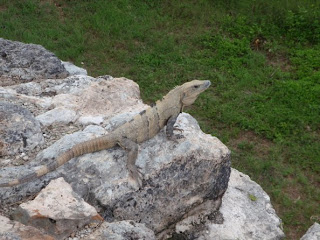This sign reads: "Community in civil resistance. NO higher electricity costs! NO privatization of utility companies!"
our stealth campsite near Toniná ruins
Toniná was to be our first visit to the famed Mayan ruins of Chiapas and the Yucatán peninsula. We arrived early in the morning and were the only visitors at the site...
Toniná, among green rolling countryside:
stucco image of a demon carrying a beheaded skull and dancing wildly
Toniná is reputed to have the highest of the Mayan temples, with very steep steps
For the Toniná Mayans, this cross represents the threshold between earth and the underworld. When light travels through this thick wall, it symbolizes the soul crossing over to the spirit world.
this figure wears a necklace of cacao pods, which were used to make chocolate/maize beverage and were highly prized.
a Toniná war prisoner. They were forced to grow their hair long, so that at the time of beheading the skulls could be carried and shown off.
Mayans practiced skull shaping, and the Toniná preferred the shape of a corn kernel.
like the live prisoners, statues were also sometimes ritualistically beheaded!
...Mayan royalty...
... Zapatista communities near Ocosingo. The above sign reads: "You are in Zapatista Territory, where the people rule and the government obeys."...
The rugged Chiapas landscape, as we begin to descend towards Palenque and tropical forest...
...classic Chiapas scenes of Zapatista villages and campesino lifestyle. Below, we encounter a controlled burn near the roadway...
a cosmic glowbug alights on Jeff's mosquito net
We arrived next at the famous ruins of Palenque, a series of temples and pyramids surrounded by rainforest:
We caught up with some howler monkeys at midday just near the ruins:
the lush forest around Palenque
conejo (rabbit) skull representation on one of Palenque's premier temples
bird man
Mayan hieroglyph
jade mask of a Mayan ruler, found in the burial tomb
ritual incense burner
classic Mayan form
in the nearby town of Palenque, frozen popsicles: cheap, delicious, and featuring Popeye
as we left Chiapas, the terrain eased up and featured long slow rivers and lots of flat cycling
these boys were enthralled by Jason's bike and didn't fail to notice Santa Muerte either!
near Champotón, our only experience of the Gulf of Mexico on this trip
Now rolling across the Yucatán peninsula, the following images are of the site Edzná, which was a large Mayan city:
taking advantage of fallen ripe papaya in roadside plantations:
We next visited Kabah, almost unvisited and unheralded, and the site of some amazing discoveries:
... bats and iguanas, local inhabitants of the ruins...
Kabah featured some astounding religious buildings:
the site is so rich, and so under-catalogued, that striking examples of Mayan building are just laying in piles around the site.
...ornate temple walls...
...this one featuring a rare elephant trunk form, even more rare that it is still intact. The facade of the building was originally covered with these, and only this one remains.
the arch that leads to the famous ruins of Uxmal some 40 km away
Kabah, as seen from a nearby unrestored pyramid, after an afternoon rain
ha ha, we didn't go there
Halfway across the Yucatán on secondary roads, this is what happens if you travel without maps and ask the police for directions. This police station took theirs off the wall and let us study it for 20 minutes.
Our next stop was to be Ek Balam, about 200 km from Cancún.
... iguanas...
... stucco figures...
... and a giant temple which gives the site its name, Ek Balam. This means Jaguar in Mayan language, and this temple is shaped like a jaguar head, framed by teeth, with the center of the mouth the temple entrance.
As seen here at the start of the rainy season, Ek Balam is set amidst thick green forest. Nearby is the cenote of Xcanche, which we visited by bike on a great track:
Jason takes a bike taxi for a spin
Cenotes are big sinks in the limestone topography of the Yucatán, filled with fresh cool water, surrounded by shade, and popular among locals as summer cooling spots.
The spectacular Xcanche is reputed to have been the haunts of Mayan kings and princesses.
Unfortunately, leaving the Ek Balam area, we encountered roadside garbage dumps (not the only ones we passed, either). The Yucatán is sadly far from clean and pristine.
Jason contemplating a Yucatán sunset, on a secondary road that clearly shows the flat and untrafficked nature of the peninsula.
a millipede in our path
near Cancún now, drying our clothes after doing some roadside laundry










































































1 comment:
Very nice! In San Cristobal right now and about to ride to Palenque. We're you able to take back roads all the way there? What did you use for maps? Cheers, Alan
Post a Comment